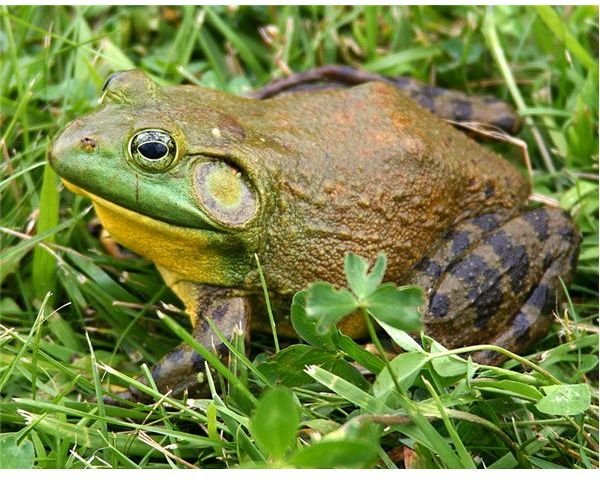North America Bullfrog: Habitat, Diet, Reproduction, Characteristics and Human Use
The North American Bullfrog (Rana Catesbeiana) is a member of the Ranidae family and is considered an aquatic frog. These frogs can be found throughout most of North America in large bodies of water, lakes, swamps and ponds. It often rests along the water’s edge, but also can be found on land when the weather is warm and rainy. This frog can also be found in British Columbia and Nova Scotia.
The North America Bullfrog is the largest of all of the North America Ranids. The typical body length and weight of this frog is 7.9 inches and 1.7 pounds. The females tend to be bigger than the males. The North American Bullfrog tends to be different shades of brown or green and may have dark blotches.
The fertilization is external in North American Bullfrogs, meaning that as the female lays the eggs the may releases his sperm onto them. These frogs begin breeding late in the spring or early in the summer and the males tend to attract the females to their territory. It takes three to five days for the eggs to hatch and metamorphosis can take just a few months (in the south) up to three years (in the north). The average lifespan of a North American Bullfrog is 8-10 years, but those that are captive may live a bit longer with the longest captive lifespan being 16 years.
North American Bullfrogs eat a rather diverse diet, but they tend to prey on things that they can easily overpower and shove down their throats. Some of their prey include invertebrates, insects, rodents, bats, small turtles, birds, snakes and other frogs. The North America Bullfrog is considered an ambush predator and this means that they find a spot and wait quietly and motionless for their prey then when the time is right they act on it. They can jump one to two meters so this allows them to often surprise their prey.
Humans have little use for the North America Bullfrog. In the southern and Midwestern part of the United States, these frogs are sometimes used as food. It is illegal in some states though, to break the skin of these frogs when hunting them. The North American Bullfrog is also a popular choice when it comes to choosing frogs to dissect in science classes across the globe.
Photo Credit
https://commons.wikimedia.org/wiki/File:North-American-bullfrog1.jpg
